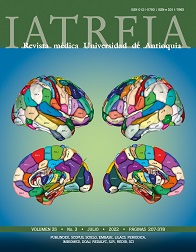What neuroscience is to be taught when neuroscience is taught? Two explanatory-models of the human brain
DOI:
https://doi.org/10.17533/udea.iatreia.163Keywords:
Anatomy , Education , Medicine , Neurology , Neuroscience , PhysiologyAbstract
In the last half-century, neuroscience has managed to gain a hegemonic position in the current cultural and academic framework. In this article, we discuss two models to explain the human brain. On the one hand, there is the classical neuroscience model, which is the common way in which neuroscience is currently taught, it usually divides the brain into lobes or areas. On the other hand, there is the sociobiological informational model that treats the brain as an integrated dual system: paleocortex and neocortex, the latter being (consciousness) what a person has internalized in the course of a life in society. The objective of this review is to present these two models or approaches (the “classical” and the “sociobiological informational”)
to explain the human brain (one of the great issues that any teaching of neuroscience is obliged to touch).
Downloads
References
(1) Kandel E. In search of memory: The Emergence of a New Science of Mind. New York: W. W. Norton & Company; 2006.
(2) Contreras-Pulache H, Espinoza-Lecca E, Moya- Salazar J. Aproximación biográfica a Pedro Ortiz Cabanillas (1933-2011) y su Teoría Sociobiológica Informacional en el contexto de la neurología científica peruana. Int J Morphol. 2019;37(4):1316-24. DOI 10.4067/S0717-95022019000401316.
(3) Ortiz P. La explicación informacional, Obra breve 1984-2011. Lima: EDUNEURO; 2019.
(4) Ortiz P. El Sistema de la Personalidad. 2da Ed. Lima: Fondo Editorial de la Universidad de Ciencias y Humanidades; 2016.
(5) Herculano-Houzel S. The human brain in numbers: a linearly scaled-up primate brain. Front Human Neuros. 2009;3:31. DOI 10.3389/neuro.09.031.2009.
(6) Netter F. Atlas of Human Anatomy. New York: Saunders; 2014.
(7) Brodmann K, Garey L. Brodmann’s Localisation in the cerebral cortex. New York: Springer; 2006.
(8) Amunts K, Zilles K. Architectonic Mapping of the Human Brain beyond Brodmann. Neuron. 2015;88(6):1086-07. DOI 10.1016/j.neuron.2015.12.001.
(9) Glasser M, Coalson TS, Robinson EC, Hacker CD, Harwell J, Yacoub E, et al. A multi-modal parcellation of human cerebral cortex. Nature. 2016;536(7615):171-8. DOI 10.1038/nature18933.
(10) Fan L, Li H, Zhuo J, Zhang Y, Wang J, Chen L, et al. The Human Brainnetome Atlas: A New Brain Atlas Based on Connectional Architecture. Cerebral Cortex. 2016;26(8):3508-26. DOI 10.1093/cercor/bhw157.
(11) Shannon C. A Mathematical Theory of Communication. Bell Syst Tech J. 1948;27:379–423.
(12) Wiener N. Cybernetics: Or Control and Communication in the Animal and the Machine. Cambridge: MIT press; 1948.
(13) Ursul A, Semeniuk E. Aspectos filosóficos del concepto de información. Rey. Ciencias Sociales (Moscú). 1978;4:215-21.
(14) Contreras-Pulache H, Moya-Salazar J. In Memoriam: Pedro Ortiz Cabanillas (1933-2011). Pan-American J Neurop. 2019;13(2):187-8. DOI 10.7714/CNPS/13.2.702.
(15) Ortiz P. Conferencias 2000-2010. Lima: Centro de Documentación e Investigación Pedro Ortiz Cabanillas; 2021.
(16) Ortiz P. El Rol de las Neurociencias en la Explicación de la Actividad Psíquica. En: Ríos-Carrasco R, Zambrano M, Castillo-Durante A, y Gonzáes-Norris L. (Eds.), Anales del VIII Congreso Nacional de Psiquiatría. Lima: Asociación Psiquiátrica Peruana, 1984;8:180-6.
(17) Ortiz P. Cuadernos de Psicobiología Social 1. Introducción a una Psicobiología del Hombre. Lima: Fondo Editorial de la Universidad Nacional Mayor de San Marcos; 2004.
(18) Zumaeta P. Glosario (mínimo) de psicobiología social informacional. En: Ortiz P. (Eds.). Neurociencia Clínica. Lima: Fondo Editorial de la Universidad Nacional Mayor de San Marcos; 2019.
(19) Ortiz P. Psicobiología Social (tomo 2). Lima: Fondo Editorial de la Universidad de Ciencias y Humanidades; 2017.
(20) Ortiz P. Psicobiología Social (tomo 3). Lima, Fondo Editorial de la Universidad de Ciencias y Humanidades; 2017.
(21) Ortiz P. Cuadernos de Psicobiología Social 6. El nivel consciente de la actividad personal. Lima: Fondo Editorial de la Universidad Nacional Mayor de San Marcos; 2004.
(22) Fuster J. The Neuroscience of Freedom And Creativity. Massachusetts: Cambridge University Press; 2013.
(23) Kurzweil R. How to Create a Mind: The Secret of Human Thought Revealed. New York: Viking Press; 2012.
(24) Ortiz P. Introducción a la Medicina clínica 3. El examen neurológico integral. Lima: Fondo Editorial de la Universidad Nacional Mayor de San Marcos; 1999.
(25) Ortiz P. Introducción a una Psicobiología del Hombre. 2da Ed. Lima: Fondo Editorial de la Universidad Nacional Mayor de San Marcos; 2010.
(26) Bennett M, Hacker P. Philosophical Foundations of Neuroscience. Nueva Jersey: Wiley-Blackwell; 2003.
(27) Adolphs R. The unsolved problems of neuroscience. Trends in Cognitive Sci. 201519(4):173-5. DOI 10.1016/j.tics.2015.01.00.
Published
How to Cite
Issue
Section
License
Copyright (c) 2022 Iatreia

This work is licensed under a Creative Commons Attribution-ShareAlike 4.0 International License.
Papers published in the journal are available for use under the Creative Commons license, specifically Attribution-NonCommercial-ShareAlike 4.0 International.
The papers must be unpublished and sent exclusively to the Journal Iatreia; the author uploading the contribution is required to submit two fully completed formats: article submission and authorship responsibility.














